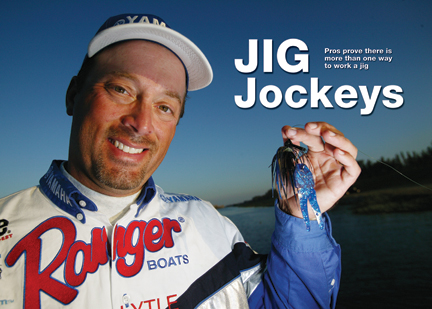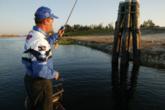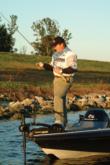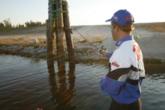Jig jockeys
Pros prove there is more than one way to work a jig

No other lure has accounted for so much money in tournament winnings as a jig. They go places and do things no other bait can, and they catch bass 12 months a year in any situation. They are available in a variety of sizes and countless colors, and they can be fished in an unlimited number of ways. These days, however, most anglers either pitch a jig to visible targets or flip it into open pockets within thick cover.
Both are highly effective techniques and ones that every bass angler needs to master in order to become a well-rounded fisherman. But pitching and flipping are limited in their effectiveness. They don’t work in deep water, and both techniques only cover a pinpoint location. That’s why a handful of professional anglers use jigs in a variety of ways.
“In order to consistently catch bass on a jig, you have to be able to use them in ways other than pitching and flipping,” said Virginia pro Curt Lytle. “Those methods are my strengths, but I won’t hesitate to try other retrieves when I think those other techniques will catch more fish. Jigs are tools just like any other lure, and in order to use them to their fullest ability, you have to use them in ways other than pitching and flipping.”
“Casting a jig and bringing it back across the bottom has almost become a forgotten technique,” said Hot Springs, Ark., pro Rob Kilby. “I use it regularly in the spring when prespawn bass are still holding in deeper water, and I’ve won a lot of money by casting a small Terminator Tiny-T jig and crawling it along the bottom.”
Contrary to the general rule that larger lures catch bigger bass, Kilby favors a smaller jig, either a quarter-ounce or 5/16-ounce for early-spring casting. He catches all sizes of bass on a little Terminator jig, but the six-time Wal-Mart FLW Tour Championship qualifier says the larger bass are often the hardest bites to detect.
“When the water is cold, the fish tend to just barely grab it, and you often never feel the bite,” Kilby said. “You’ll just feel dead weight, so you have to set the hook when it just doesn’t feel right or when you feel that dead weight.”
Casting works best when the bass are holding in deeper water – Kilby favors depths of 7 to 25 feet – and when the water is between 39 and 47 degrees. It’s an excellent way to cover lots of water, and it does a great job of imitating a crawfish, a favorite food of all types of bass.
“I like to cast a jig on steeper banks close to a river or creek channel, particularly where the channel swings and the steep bank kind of flattens out to a more gently sloping bank,” Kilby said. “You can often pinpoint a specific pattern and really key in on small pockets in those corners where the bank transitions from steep to flat. If the bottom is rocky, that’s even better, because that’s where crawfish tend to live.”
The key to catching bass with this technique, adds Kilby, is to fish it slowly, something many of his co-angler partners do not do. In fact, nothing is more important than working the bait along the bottom at a painfully slow speed. He favors 10-pound monofilament rigged on a bait-casting outfit and says the lighter line rarely costs him fish.
“I’m usually fishing open banks, and when a bass grabs a lure, he tends to swim out toward the boat anyway, so I rarely have to worry about getting hung,” Kilby said.
Pitch-skipping
The ability to put a lure in places other anglers cannot will increase your odds of catching bass, particularly when heavy fishing pressure or a drastic weather system pushes fish far up under cover. That is exactly why New Jersey pro Mike Iaconelli developed his trademark jig technique – pitch-skipping. It employs a Mann’s Stone Jig, a flat-headed lure that Iaconelli developed, and a combination side-armed pitching and skipping cast. It is a technique that allows him to put a jig way up under docks, ropes and other low-slung cover with a bait-casting rig.
“Anybody can skip a lure far under a low dock on spinning tackle, but you are limited in the line you can use,” Iaconelli said. “At best, you can use 12-pound mono on spinning tackle, so you tend to lose those bigger fish around the docks and other obstacles. By skipping a Stone Jig under docks with bait-casting equipment, I can use 17- or 20-pound line and eliminate the risk of losing the bigger fish that go way up under low cover. The fish see tubes, floating worms and soft-plastic jerkbaits all the time, but very few anglers can put a jig way up under a dock on bait-casting equipment.”
Skipping anything with bait-casting equipment can be a nightmare, and you’ll likely spend more time picking backlashes from your spool than fishing when you first try this technique. Even Iaconelli has to work those annoying loops out of his line occasionally, but it’s a trade-off he’s willing to make.
“Keep practicing. Eventually, you’ll be able to loosen the magnet on your bait-caster and you can put the lure way back up under places very few others are able to,” he said.
Swimming
Inching a jig across the lake bottom is a great way to entice sluggish bass, but when fish are either suspended under floating docks or in the mood to chase a faster-moving bait, Lytle ties on a 3/8-ounce Berkley Power Jig and swims it around cover.
“It’s a great technique on pressured lakes,” Lytle said. “I prefer to use it when the water is 65 degrees or warmer, because the fish will be more active. It’s just a good substitute for a crankbait or spinnerbait, and I’ll use one if the cover I’m fishing is getting worked over by others.”
Ideally, Lytle wants the bass to be in the upper 5 feet of water. In other words, the fish can be suspended over 50 feet as long as they are within 5 feet of the surface, or on the bottom as long as the water is only 5 feet deep. That allows him to keep his bait moving at his preferred speed while allowing the bass to see the lure.
“I’m going to just swim it along like I’m slow-rolling a spinnerbait,” he said. “I don’t really give it much action. How deep I swim it depends on the water clarity or on how deep the fish are. Typically, I want to swim it just so it’s out of sight, but I’m going to try different depths until the fish tell me where they are.”
Lytle almost always uses a black/blue 3/8-ounce Power Jig, adding that he’s not sure what the lure imitates as it moves through the water. Truth is, he doesn’t really care as long as it catches fish.
When bass refuse everything else, Rick Lillegard ties on a half-ounce football-head jig and drags it across the bottom in areas he knows hold good fish. It is a technique he does not use often, but when he does, it can pay huge dividends.
“Bigger bass seem to react better to a super-slow presentation, and that’s exactly how I fish a jig sometimes,” said the New Hampshire pro. “The idea is to drag the jig along the bottom without ever lifting it up, like a crawfish would move. The compact weight of the jig also allows me to get a good feel for the bottom. I can detect really subtle differences – structure within structure.”
It is primarily a summer pattern and one Lillegard uses when the fish are holding in depths from 15 to 25 feet. He’ll use jigs up to 3/4-ounce and says the largest bass tend to favor that larger jig.
“Some retrieves will take five minutes or more if I’m confident the fish are there. That’s how slow I crawl it,” he said. “I keep my rod tip level like I was fishing a Carolina rig and just drag it without ever lifting the jig up off the bottom.”
Popping
A video camera and a hunch helped Jim Carnell earn a new boat during a tournament near his home in Oklahoma last year. The Wal-Mart FLW Tour pro discovered a large number of bass holding on a series of stair-step ledges with the help of an underwater video camera. During practice, the bass were willing to take a jig crawled across those ledges, but during the tournament, the jig bite tapered off.
“I’m not really sure why, but I just started popping the jig up and letting it fall as I worked it down those ledges. Man, that really triggered the bass to bite,” Carnell said. “They would hit it as it fell.”
The same technique works well in grass. Carnell says the key is to pop the jig up through the grass, allowing it to fall back to the bottom. Strikes will either come on the fall or as the bait rests on the bottom.
Not only can the Wal-Mart FLW Tour’s top anglers recognize the prime spot to drop their jig, they can put it in a dime-sized hole when they have to. In Curt Lytle’s case, he can do it with either his left or right hand.
“I learned to pitch and flip with my left arm after I just got tired of using my right arm all the time,” he said. “My right arm was sore at the end of every day, so I just tried using my left hand for some relief. It took a while to learn, but now I’m almost as proficient at flipping with my left arm as I am with my right.”
 Aside from the obvious benefit of physical relief, that ambidextrous versatility has given the Suffolk, Va., angler the ability to hit targets other anglers might pass up. As he works his way down a shoreline, Lytle can put his jig on the money no matter what angle the target lies.
Aside from the obvious benefit of physical relief, that ambidextrous versatility has given the Suffolk, Va., angler the ability to hit targets other anglers might pass up. As he works his way down a shoreline, Lytle can put his jig on the money no matter what angle the target lies.
“It’s just a matter of practice,” he said. “You have to keep at it, and eventually, you’ll master the technique.”


